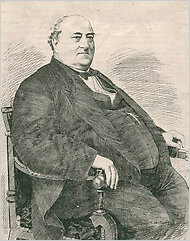Isaac H. Brown
Appearance

Isaac H. Brown (1812-1880) was the sexton at Grace Church in Greenwich Village, and arbiter of style in Manhattan where he planned weddings, arranged soirées and funerals for the wealthy of New York City.[1][2] His contribution to high society was so essential, a society journalist reported in 1850, that without him, "the ladies of our fashionable world would be at a loss to fill up their lists, the young gentlemen be without a patron, the carriages would stray about like lost sheep, the servants be wayward and fitful in their movements, and the whole charm of our social assemblages be gone."[3]
References
- ^ Alan Feuer (July 11, 2010). "A Sycophant's Sycophant". New York Times. Retrieved 2010-07-12.
Mr. Brown, who died 130 years ago, was the longtime sexton at Grace Episcopal Church in Greenwich Village, an official title that belied his real role as the amanuensis to, and the arbiter of fashion in, Knickerbocker society. ...
- ^ "Death Of Sexton Brown. The Veteran Of Grace Church Dies In Connecticut. Malarial Fever The Cause. His Career From The Days When He Was A Carpenter". New York Times. August 23, 1880. Retrieved 2010-07-12.
Isaac H. Brown, the venerable sexton of Grace Church, died yesterday morning at Branford, a little village a few miles north of New-Haven, Conn. He had been a leading figure in Metropolitan society for nearly half a century, having had charge of most of the fashionable weddings and many of the funerals of noted personages among the Knickerbocker families.
- ^ Mitchell, Donald G. (March 14, 1850). The Lorgnette; or, Studies of the Town, by an Opera Goer. New York: Stringer and Townsend. pp. 183–84.
